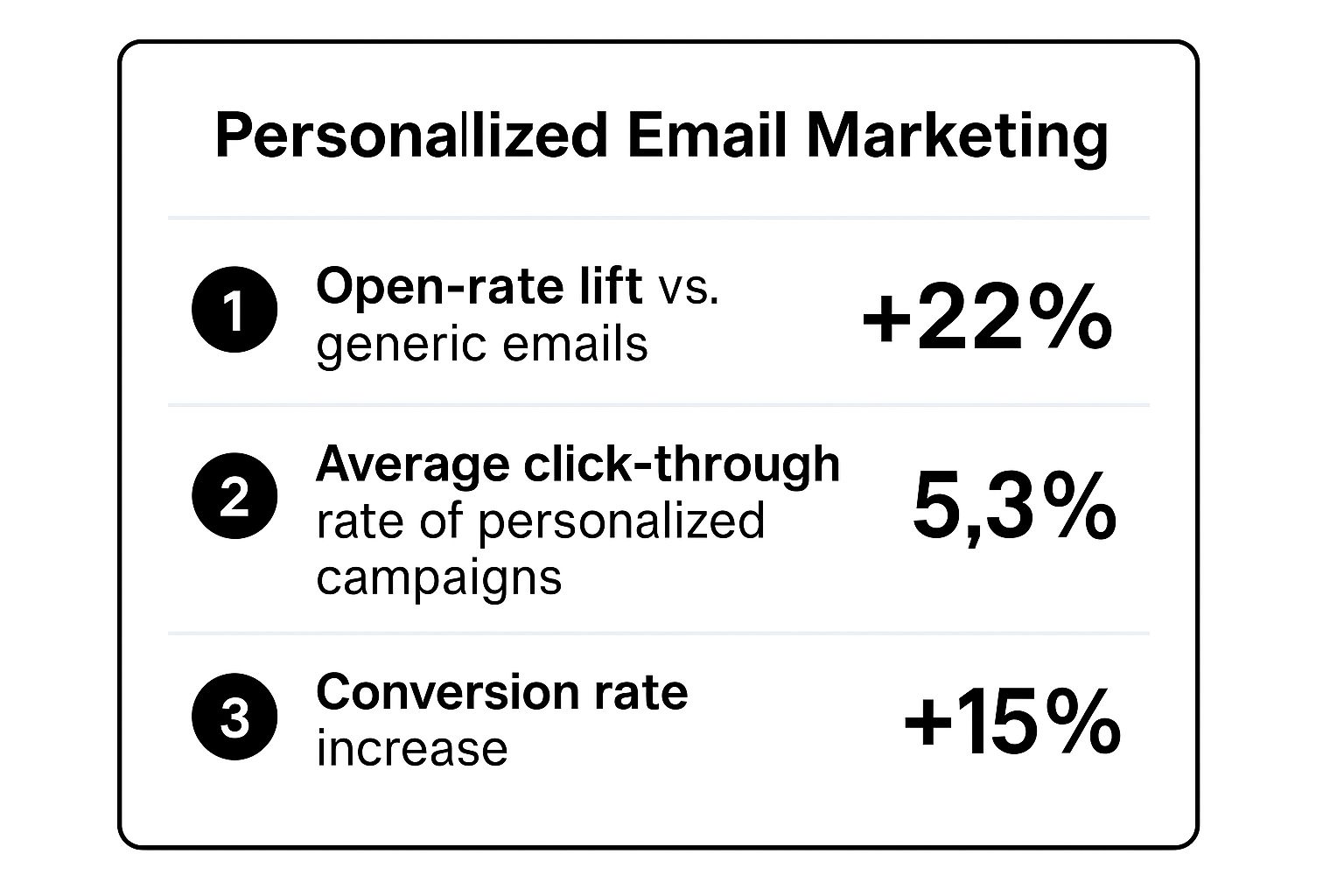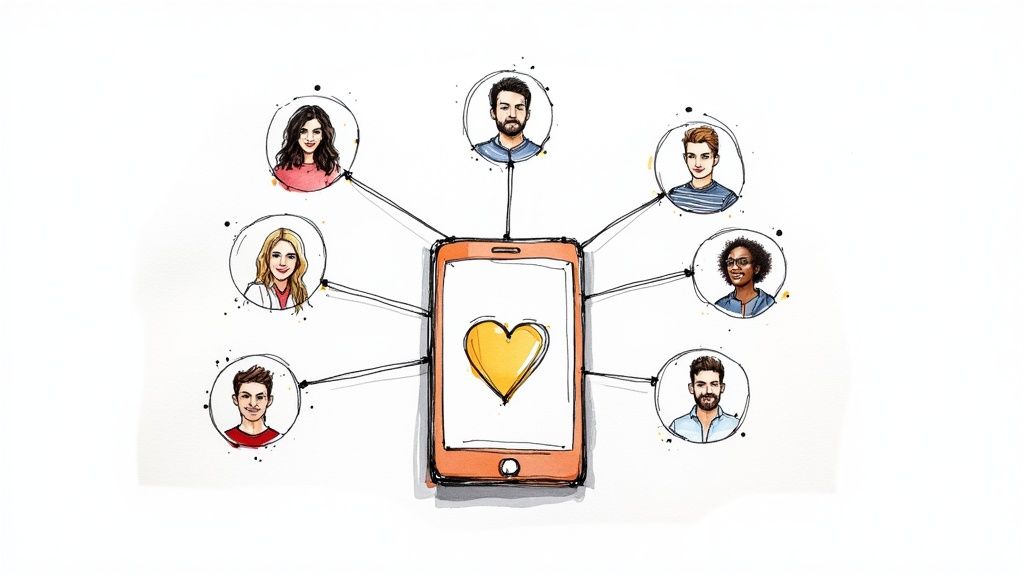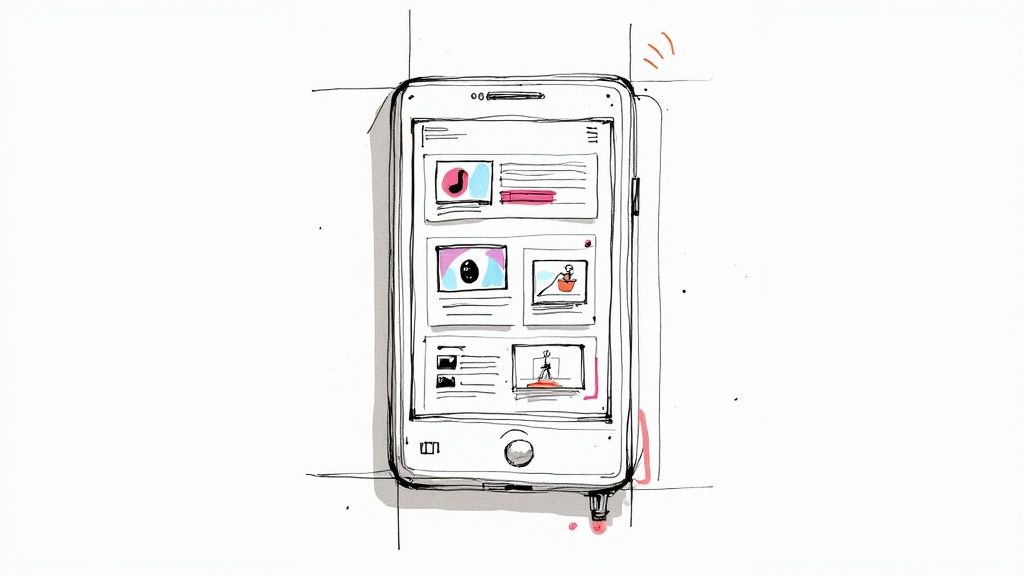
7 Powerful Customer Engagement Examples for 2025
In today's crowded market, generic outreach no longer captures attention. Customers expect personalized, two-way conversations that provide genuine value, moving beyond passive consumption to active participation. But how do you transform standard content into a compelling experience? The answer lies in making it interactive.
This article dissects 7 powerful customer engagement examples that leverage dynamic features to captivate audiences and drive measurable results. We will move past surface-level descriptions to provide deep strategic analysis, actionable takeaways, and replicable methods you can implement immediately. You will learn precisely how leading brands use tools like quizzes, in-video branching logic, and personalized content journeys to redefine customer relationships.
Get ready to explore a curated collection of strategies spanning marketing, sales, and training. We will highlight how platforms like Mindstamp orchestrate these dynamic experiences, turning passive viewers into active participants. From gamified loyalty programs and interactive content marketing to personalized email campaigns and robust social media communities, you will find concrete tactics to elevate your engagement strategy. This guide is designed to show you not just what works, but why it works and how you can replicate that success.
1. The Personalized Email Campaign That Feels Like a Conversation
Personalized email marketing moves beyond simply inserting a first name. It leverages customer data, behavioral patterns, and stated preferences to deliver highly targeted content that feels like a one-on-one conversation. This strategy transforms a mass communication channel into a tool for building individual relationships, making it one of the most effective customer engagement examples available.
Instead of a generic blast, recipients receive emails with relevant product suggestions, content aligned with their past interactions, and offers tailored to their specific needs. Giants like Netflix and Spotify excel at this, with Netflix sending curated show recommendations based on viewing history and Spotify delivering its popular "Discover Weekly" playlists. These campaigns succeed because they provide genuine value, making customers feel understood rather than just marketed to.
Strategic Analysis & Actionable Tips
To implement this effectively, focus on gathering and using data intelligently.
- Start with Segmentation: Before full personalization, group your audience by demographics, purchase history, or engagement level. This is a foundational step.
- Use Progressive Profiling: Don't ask for all information at once. Use forms and interactive content to gather data over time, enriching customer profiles gradually.
- Systematic A/B Testing: Test different personalization elements, such as subject lines with location data versus past purchase data, to see what resonates most.
Strategic Insight: The core principle is reciprocity. By using a customer's data to provide tangible value (like a great recommendation or a relevant discount), you earn their attention and trust. This builds a positive feedback loop where customers are more willing to share information, enabling even deeper personalization.
Why It's a Top Engagement Strategy
This approach works because it directly addresses the customer's implicit question: "What's in it for me?" By answering with hyper-relevant content, you significantly increase the chances of an open, a click, and a conversion. It’s a powerful method for re-engaging dormant users, recovering abandoned carts, and building long-term brand loyalty. These same personalization principles can be extended to other channels as well; for instance, you can learn more about how to personalize your video content for even greater impact.
This infographic highlights the impressive performance metrics of well-executed personalized email campaigns.

The data clearly shows that personalization isn't just a "nice to have" feature; it's a significant driver of core marketing KPIs, boosting everything from initial engagement to final conversion.
2. Social Media Community Building
Social media community building moves beyond simply broadcasting marketing messages. It involves creating a dedicated online space where customers, fans, and prospects can connect with the brand and each other around shared interests. This approach prioritizes genuine interaction and relationship-building over direct selling, transforming followers into a loyal and engaged community.

Instead of just pushing products, brands foster conversations, encourage user-generated content (UGC), and provide value that extends beyond their offerings. A prime example is Glossier, which built its empire by cultivating an Instagram-first community where beauty enthusiasts share tips and photos. Similarly, the Harley-Davidson Owners Group (H.O.G.) creates a powerful sense of belonging that is core to the brand's identity, proving that this is a top-tier customer engagement example.
Strategic Analysis & Actionable Tips
To build a thriving community, you must act as a facilitator, not just a marketer.
- Establish Clear Guidelines: Create and enforce community rules to ensure interactions remain positive, respectful, and on-topic. This protects the space for all members.
- Encourage User-Generated Content: Actively prompt users to share their experiences. Run contests, create unique hashtags, and feature member posts to make them feel valued.
- Be Responsive and Authentic: Engage in conversations authentically. Respond to comments and messages promptly, ask questions, and show the human side of your brand.
Strategic Insight: The goal is to shift from a "brand-to-customer" monologue to a "brand-and-community" dialogue. When a brand successfully creates a space for shared identity, members become its most passionate advocates, driving organic growth and building social proof that no advertisement can buy.
Why It's a Top Engagement Strategy
This approach works because it taps into the fundamental human need for connection and belonging. By providing a platform for these connections, a brand becomes an integral part of its customers' lives, not just a line item on a credit card statement. This deep-seated loyalty leads to higher customer retention, valuable feedback, and powerful word-of-mouth marketing, making it one of the most sustainable customer engagement examples.
3. Gamification and Loyalty Programs
Gamification integrates game-like mechanics such as points, badges, and leaderboards into non-game contexts to boost user participation and long-term retention. By tapping into our intrinsic desires for achievement, competition, and reward, these programs transform mundane interactions into compelling and enjoyable experiences, making them a cornerstone of modern customer engagement examples.
This strategy encourages repeat behavior and builds a strong sense of community and brand loyalty. Iconic examples include the Starbucks Rewards program, where customers earn "Stars" to unlock free items and tier levels, and Duolingo's language-learning app, which uses streaks and XP points to motivate daily practice. These systems work because they make progress visible and rewarding, encouraging customers to stay involved.

Strategic Analysis & Actionable Tips
An effective gamified program requires a deep understanding of user motivation and careful design.
- Make Rewards Meaningful: Ensure the rewards, whether discounts, exclusive content, or status symbols, align with what your customers genuinely value. An irrelevant reward fails to motivate.
- Use Clear Progress Indicators: Implement visual cues like progress bars, level trackers, or point counters. This gives users a clear sense of accomplishment and keeps them motivated to reach the next milestone.
- Incorporate Social Elements: Add leaderboards, team challenges, or shareable badges to foster a sense of community and friendly competition. Social proof is a powerful motivator.
Strategic Insight: The key to successful gamification is creating a balanced system of effort and reward. The challenges should be achievable enough to prevent frustration but difficult enough to make the rewards feel earned. This balance creates a satisfying feedback loop that drives sustained engagement.
Why It's a Top Engagement Strategy
Gamification excels at turning passive users into active participants. It provides a structured framework for continuous interaction that goes beyond simple transactions. This approach is highly effective for increasing customer lifetime value, encouraging specific user behaviors (like completing a profile or making a repeat purchase), and gathering valuable data on customer preferences. By making engagement feel like a game, brands can build an emotional connection that transactional relationships alone cannot achieve.
4. Interactive Content Marketing
Interactive content marketing transforms passive content consumption into an active, two-way dialogue. By creating experiences that require user participation, such as quizzes, polls, calculators, and interactive videos, brands can capture attention far more effectively than with static text or images. This strategy moves beyond broadcasting a message and instead invites customers into a memorable, participatory brand experience.
This approach provides value to both sides. The customer receives personalized results, useful information, or simple entertainment, while the brand gathers valuable zero-party data and boosts engagement metrics. Excellent examples include HubSpot's "Website Grader" tool, which provides users with a custom report in exchange for their information, and BuzzFeed’s viral personality quizzes, which generate massive social shares. These succeed by offering an immediate, tangible benefit for a moment of the user's time.
Strategic Analysis & Actionable Tips
To deploy interactive content successfully, the focus must be on creating genuine value, not just a gimmick.
- Align with User Intent: Ensure the interactive element directly addresses a user's need or curiosity. A mortgage calculator on a real estate site is useful; a random quiz is not.
- Prioritize Performance: Interactive elements can be heavy. Keep loading times minimal to prevent user drop-off, and test rigorously across all major devices and platforms.
- Make it Sharable: Design the results to be easily shared on social media. This turns engaged users into brand advocates, amplifying your reach organically.
Strategic Insight: The power of interactive content lies in its ability to create a "value exchange." The user invests their time and attention, and in return, they receive personalized insights or entertainment. This exchange builds a stronger connection than passive consumption and provides you with explicit data to personalize future interactions.
Why It's a Top Engagement Strategy
This method is one of the best customer engagement examples because it taps into the human desire for discovery and personalization. It gives users a reason to spend more time with your brand, leading to higher recall and deeper brand affinity. The data collected from quizzes, polls, and calculators is highly specific, allowing for precise audience segmentation and targeted follow-up campaigns. It's a powerful tool for lead generation, customer education, and turning passive viewers into active participants.
You can learn how to create compelling interactive video content that captivates audiences and drives action.
The video above demonstrates how interactive elements can be seamlessly integrated into marketing, creating a more dynamic and engaging user journey that drives tangible business results.
5. Omnichannel Customer Support
Omnichannel customer support elevates service by creating a seamless, unified experience across all customer touchpoints. It goes beyond multi-channel support by integrating conversation history and customer data, ensuring that context is never lost when a customer switches from a live chat to a phone call or an in-store visit. This approach eliminates the frustration of repeating information and makes customers feel their entire journey with the brand is recognized and valued.
This strategy is one of the most powerful customer engagement examples because it prioritizes customer convenience and reduces friction. Leading brands like Disney master this with their MagicBand system, which connects park, hotel, and app experiences into a single, cohesive journey. Similarly, Apple provides a fluid support experience, allowing a customer to start a chat online, schedule a Genius Bar appointment, and have the technician already know the full history of the issue.
Strategic Analysis & Actionable Tips
Effective omnichannel support hinges on deep integration and a customer-first mindset.
- Invest in a Centralized CRM: Your Customer Relationship Management (CRM) system must be the single source of truth, consolidating interactions from every channel. This is non-negotiable for true omnichannel success.
- Train for Consistency: Equip your support team to handle inquiries from any channel with a consistent brand voice and service quality. They should be able to see the customer’s full history regardless of the touchpoint.
- Map the Customer Journey: Identify all potential touchpoints a customer might use and ensure the transitions between them are seamless. Test these pathways rigorously to find and fix any broken links.
Strategic Insight: The goal is to make the channel invisible to the customer. They shouldn't have to think about whether they are on your app, website, or social media; the experience should be consistently helpful and contextually aware. This builds profound trust and makes engagement effortless.
Why It's a Top Engagement Strategy
Omnichannel support directly boosts customer satisfaction and retention by showing you respect their time and history. It transforms customer service from a reactive cost center into a proactive, relationship-building asset. By solving problems efficiently and personally, you create brand advocates who are more likely to remain loyal and recommend your services. These principles of seamless, data-driven interaction are also crucial in digital experiences; you can explore new ways of using interactive video to drive SaaS customer engagement to further enhance your support.
6. User-Generated Content Campaigns
User-generated content (UGC) campaigns shift the spotlight from the brand to the customer, encouraging them to create and share content related to a product or service. This strategy leverages the authenticity of real customer experiences to build trust, foster a sense of community, and dramatically expand brand reach. It's one of the most powerful customer engagement examples because it turns passive consumers into active brand advocates.
Instead of polished brand messaging, UGC campaigns thrive on genuine, user-created photos, videos, and stories. GoPro has built its entire marketing identity around this, using stunning customer-shot adventure videos to showcase product capabilities far more convincingly than any studio ad could. Similarly, Coca-Cola's "Share a Coke" campaign, which printed names on bottles, sparked a massive wave of customers sharing photos online, creating a personal connection with the global brand.
Strategic Analysis & Actionable Tips
To launch a successful UGC campaign, you need to inspire and guide participation without stifling creativity.
- Create a Clear, Compelling Hashtag: Your campaign needs a memorable and easy-to-use hashtag that serves as a digital filing system for all submissions (e.g., Starbucks' #RedCupContest).
- Offer Meaningful Incentives: Motivate participation with rewards that resonate with your audience, such as featuring their content, offering exclusive discounts, or providing prizes.
- Establish Clear Guidelines: To maintain brand safety and quality, provide simple content guidelines and have a moderation process in place to filter submissions.
Strategic Insight: The power of UGC lies in its inherent social proof. When potential buyers see real people genuinely enjoying a product, it acts as a powerful, unbiased testimonial. This authentic advocacy is often more persuasive than traditional advertising because it comes from a relatable source.
Why It's a Top Engagement Strategy
This approach works because it taps into the fundamental human desire for expression and community. It gives customers a platform to share their stories and feel like part of the brand's journey. UGC is incredibly effective for building a loyal community, generating a vast library of authentic marketing assets at a low cost, and boosting brand credibility. The engagement is deep, creating an emotional investment that transforms customers into loyal fans.
7. Personalized MobileApp Experiences
Personalized mobile app experiences leverage user data, behavior, and preferences to dynamically adapt the app’s content, features, and interface. This transforms a one-size-fits-all tool into a unique, evolving environment tailored to each individual, making it a cornerstone example of modern customer engagement. The goal is to make every interaction feel relevant, intuitive, and valuable.

Instead of presenting the same home screen to everyone, these apps showcase content and functionality based on past actions. Industry leaders like Spotify and Netflix are masters of this; Spotify’s "Discover Weekly" playlists and Netflix’s recommendation engine are prime examples. Similarly, Amazon’s app curates product suggestions and deals based on browsing history, while Uber suggests destinations based on ride patterns, making the user journey seamless and predictive.
Strategic Analysis & Actionable Tips
Effective mobile personalization requires a thoughtful, data-driven approach that respects user privacy.
- Start with Simple Personalization: Begin with basic elements like using the customer's name or showing location-specific content. Gradually introduce more complex features as you gather more behavioral data.
- Be Transparent About Data Use: Clearly communicate what data you collect and how you use it to enhance the user experience. Provide straightforward privacy controls and allow users to refine their personalization preferences.
- Use A/B Testing to Optimize: Continuously test different personalization algorithms and UI variations. For example, test a recommendation engine based on purchase history against one based on browsing behavior to see which drives more engagement.
Strategic Insight: The most successful personalized apps create a symbiotic relationship with the user. The app becomes more useful as the user interacts with it, which in turn encourages more interaction. This creates a powerful retention loop that makes the app an indispensable part of the user’s daily routine.
Why It's a Top Engagement Strategy
This strategy is highly effective because it makes an app feel essential rather than just functional. By anticipating user needs and removing friction, personalized mobile experiences significantly boost session times, user retention, and lifetime value. It directly answers the user’s need for efficiency and relevance, turning a simple app into a powerful, loyalty-building tool. These principles of data-driven relevance are also critical when you aim to boost e-learning engagement with interactive video, where personalization can make learning paths more effective.
Customer Engagement Strategies Comparison
Putting These Engagement Strategies into Action
Throughout this exploration of diverse customer engagement examples, a powerful, unifying theme has emerged: the most successful brands have moved beyond one-way communication and are actively inviting their audience into a dynamic, two-way conversation. The examples we’ve analyzed, from highly personalized email campaigns and vibrant social media communities to gamified loyalty programs and interactive content, all share this foundational principle of dialogue over monologue. They transform passive consumption into active participation.
This shift is no longer a "nice-to-have" novelty; it's a strategic imperative for modern business. By fostering genuine interaction, you're not just grabbing momentary attention in a crowded digital space. You are building the bedrock of brand loyalty, gathering invaluable first-party data, and creating a community of advocates who feel seen, heard, and valued. The strategic thread connecting these methods is a deep commitment to understanding and responding to customer needs in real-time.
Key Takeaways and Your Strategic Roadmap
To truly harness the power demonstrated in these customer engagement examples, you must move from inspiration to implementation. The core lesson is that engagement is not a single tactic but a holistic mindset that should permeate your marketing, sales, and training efforts.
Here is a summary of the most critical, actionable takeaways to guide your strategy:
- Embrace Interactivity: Passive content is becoming obsolete. The future of engagement lies in interactive experiences that empower the user. Quizzes, polls, clickable hotspots, and branching video paths are not just features; they are tools for creating personalized journeys that captivate and convert.
- Personalization at Scale: Modern tools allow you to deliver personalized experiences without an unsustainable manual workload. Use data from your CRM and analytics platforms to tailor content, recommendations, and communications, making each customer feel like their individual needs are being addressed.
- Foster Community, Don't Just Collect Followers: Building a community requires more than just accumulating likes. It involves creating a space for shared identity, facilitating user-generated content, and actively participating in conversations. This creates a powerful sense of belonging that transcends transactional relationships.
- Make It a Value Exchange: True engagement is reciprocal. Whether you're offering loyalty points, exclusive content, or simply a more efficient support experience, ensure the customer receives tangible value in return for their time and attention.
Your First Actionable Step
The most effective way to begin is by auditing your existing assets. You don't need to start from scratch. Identify a piece of high-performing, yet passive, content. Ask yourself:
- Could this product demo video become an interactive tour with clickable feature highlights?
- Can this training webinar be re-imagined with in-video quizzes to certify comprehension?
- Could this marketing video include a lead-capture form directly at the point of highest interest?
By asking these questions, you start to see opportunities everywhere. Transforming a single asset is a low-risk, high-reward way to test these strategies, gather data, and prove the ROI of enhanced engagement. Adopting these modern customer engagement examples is your pathway to not only surviving but thriving, turning fleeting interactions into lasting, profitable relationships.
Ready to transform your passive videos into powerful engagement engines? Mindstamp provides the tools you need to easily add interactive elements like questions, hotspots, and branching logic directly to your video content. Start building the compelling experiences your customers deserve by exploring Mindstamp today.
Get Started Now
Mindstamp is easy to use, incredibly capable, and supported by an amazing team. Join us!



Try Mindstamp Free










